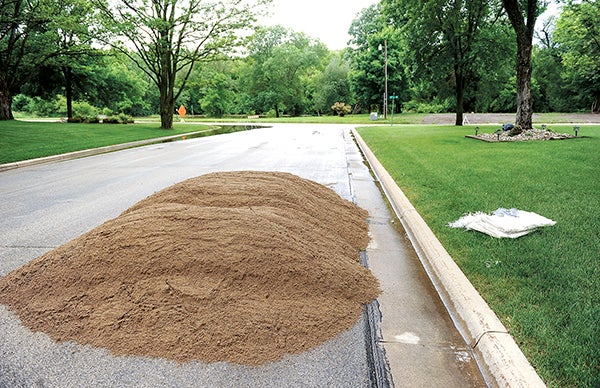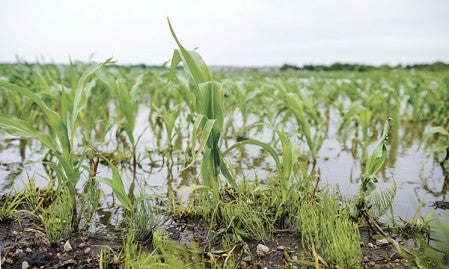Officials: Flood projects working after major rainfall
Published 10:34 am Friday, June 20, 2014

Sand and bags were set out near 22nd Street SW along the Turtle Creek Thursday afternoon as the creek’s water’s continued to rise. — Eric Johnson/photodesk@austindailyherald.com
Though Mower County had plenty of rain this week, the area survived a potential flood with minimal damage.
The Austin area saw the few effects from floodwaters throughout the week as the Cedar River, Dobbins Creek and Turtle Creek all crested at various points from Monday on. To local leaders, it’s proof the community’s flood mitigation efforts are working.
“Ultimately, things are getting better,” Public Works Director Steven Lang said. “The more properties that are acquired, the more homes that are removed from the flood plain, the less people are impacted and the more people are overall able to get on with their daily lives.”
Lang said the city’s flood mitigation efforts have been effective in preventing major damage to area homes and businesses. The city is in the midst of the final stages of the North Main Flood Control project, where workers are building a flood wall about 4 feet higher than Main Street’s current elevation, with another invisible wall adding another 3 feet.
The city made strides to lay the foundation for flood walls along the Cedar River in downtown Austin over the winter. City workers closed North Main Street in May to raise the road about two feet higher as part of an overall effort to protect the downtown area from floods. Construction workers are building a water pumping station near the Austin Municipal Pool parking lot as well as creating an eventual “invisible” flood wall, a series of aluminum stop logs that can be stacked up to three feet past the high-water mark from the record 2004 flood.
Yet the rains have delayed construction all week, according to Lang. The wet soil may make things difficult for workers over the next few weeks, but Lang said there was no permanent issues with the flood control project from this week’s flood events.
“That will dry out over time,” he said.
Workers will soon close the intersection at Main Street and Eighth Avenue and begin building flood walls and berms behind R&F Apartments, according to Lang.
Austin continues to get recognition for its flood mitigation efforts. County officials talked with Sen. Amy Klobuchar’s office Wednesday about Austin’s flood mitigation.
According to Mower County Emergency Management Director Wayne Madson, Klobuchar’s office asked how the city was impacted by this week’s flooding. Madson was happy to report the flood didn’t affect Austin as much as previous years due to the city’s flood control projects
“It’s taken a lot of areas of concern out of play now,” Madson said in reference to flood efforts.
Madson said there are less sewer systems backing up during floods, Oakland Avenue is no longer under water after they took out an overpass and straightened the road, and some of the buy outs have turned into water containment areas, which has worked out well for the city.
County effects
Yet Mower County was still affected by the rain.
Madson said some farmland near Rose Creek is under water, and although the immediate impact is hard to gauge, it will be seen as the growing season continues.
“It’s a tough one because it’s not apparent,” Madson said.
He worries portions of crops might not be able to withstand the spring flood, though farmers have reported little effects thus far.
“Overall it’s been pretty good,” said Darrell Ingvaldson, a financial agent with Farm Bureau Financial Services.
Ingvaldson said there may be pockets within the county where farmers have fields with standing water, but the spread-out rain has overall helped crops more than it hindered them.
Resource specialist for the Cedar River Watershed District and Mower County’s Soil & Water Conservation District Justin Hanson said there are concerns for some of the current projects and farmland.
“We’ve been out and there’s a few projects that are going to be in tough shape,” Hanson said.
Hanson said there is a lot of dirty water which mostly comes from farmland that has no crop protection yet. He worried some of the crops may be severely damaged.
While Hanson reported little substantial flooding and no damage to infrastructure, he noted ditches and gullies are fairly full of water, and any more rainfall could push them over the edges.
“It looks like we can handle some showers, but we just don’t want it to be a significant shot [of water],” Hanson said.
After Thursday afternoon’s rain, there’s a chance for thunderstorms through the weekend and into next week, but none are expected to be severe, according to the National Weather Service.
The three main rivers differ in levels of severity, but Hanson said they are acting like they usually do. As of this morning, flood warnings were lifted on the Cedar River and Dobbins Creek, but the warning for Turtle Creek was slated to continue through Sunday morning, unless flood waters receded sooner. Though water levels had dropped, the weather service reported waterways would be near the flood stage through the weekend.
Trey Mewes contributed to this report






